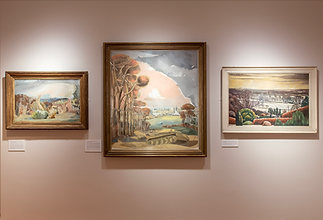Land, Sea, and Sky | Paul Nash in Oxford
Oxford Festival of the Arts
In Summer 2024, Land, Sea, and Sky drew upon the holdings of the Ashmolean Museum, the Tate archives, a number of Oxford colleges and private collections, seeking to bring the work of renowned British surrealist painter and war artist Paul Nash to a new generation of viewers – shedding light on the Oxfordshire locations that inspired his work and the Oxonian women who supported him. This project was in collaboration with Oxford Festival of the Arts and a team of curators, writers, researchers and art historians from across the country. The biggest exhibition in the Pembroke JCR Art Fund's history in terms of events, exhibition opening hours, and visitor numbers, the show was featured in numerous publications and connected artists and writers across Oxfordshire.
Dates: from the 11th May - 9th June, gallery open 11am-4pm on weekends and 4pm-7pm on Thursday & Friday.


Photo courtesy of Christopher Baines
Featured events:
A very British Surrealist? The Enduring Legacy of Paul Nash - Will Gompertz in conversation with Myroslava Hartmond (book here)
Sunday 9th June, 6pm, Pichette Auditorium, Pembroke College
Paul Nash's enduring legacy as Britain's foremost Surrealist is inextricably linked to his experience of the two World Wars. His evocative visions, such as 'Totes Meer' (Dead Sea) of 1941, inspired by aircraft wreckage at the Cowley Dumps in East Oxford, translated the prosaic ugliness of wartime into an unmistakable poetic language that conveyed his love for the English landscape.
2024 marks 100 years since André Breton advocated for 'pure psychic automatism' in his first Surrealist Manifesto and made a case for dreams as a worthy subject in art. In an unstable world torn asunder by war, the rise of totalitarianism, and sweeping social and economic change, Surrealism became the vehicle of expressing the anxiety, rage, and conflicted desires felt by leading artists of the movement, including Salvador Dalí, Joan Miró, René Magritte, Ithell Colquhoun, and Paul Nash.
Dave McKean in conversation with David Boyd Haycock (book here)
Wednesday 29th May, 6:30pm, Pichette Auditorium, Pembroke College
Dave McKean is an internationally renowned graphic artist, musician, and filmmaker whose work includes his collaboration with Neil Gaiman on The Sandman, and with Grant Morrison on the Batman graphic novel, Arkham Asylum.
In 2016 he wrote and illustrated Black Dog: The Dreams of Paul Nash, as part of the Imperial War Museum's commemoration of the centenary of the First World War. Tonight, Dave will be in conversation with Oxford-based art historian, author, curator, and lecturer David Boyd Haycock, talking about his work and the recent publication ofThalamus, a majestic 2-volume retrospective collection of his art.
Paul Nash Curatorial panel discussion - Christopher Baines, Michelle Castelletti, Jan Cox, David Boyd Haycock, Ian Holgate, Peter Vass (book here)
Wednesday 5th June, 6:30pm, Pichette Auditorium, Pembroke College
Join the curatorial team for an informal discussion on the work of Paul Nash, and how this fits within his whole output and within Oxfordshire.
